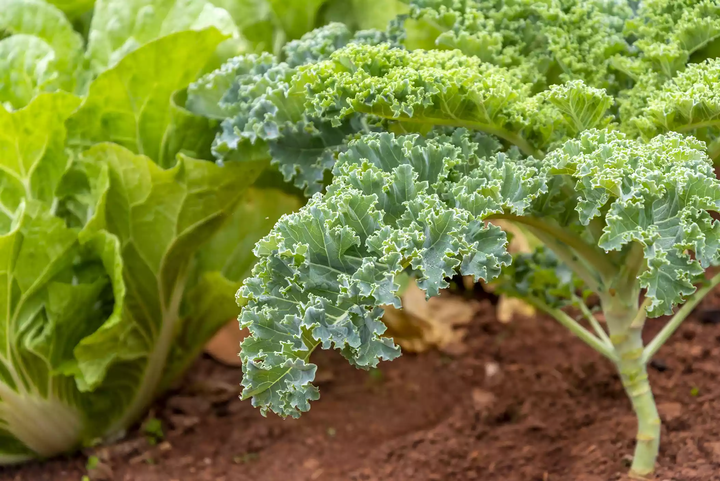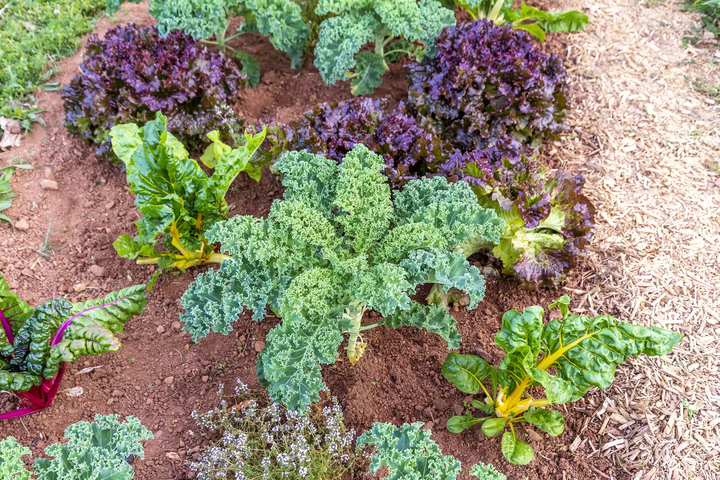Kale is a cabbage relative that is classified as Brassica oleracea var. acephala. It is essentially a form of cabbage that doesn't have the tightly formed head associated with most cabbages. A powerhouse of nutrients, kale is usually grouped in the cooking greens category with collards, mustard, and Swiss chard. Kale plants can be quite ornamental, with textured and curly leaves that come in shades of green, purple, and more. The plants are usually considered a cool-season vegetable and can handle some frost once they're mature.
Botanical Name:
Brassica oleracea
Common Name:
Kale
Plant Type:
Annual or biennial vegetable
Mature Size:
1 to 2 feet tall with a similar spread
Sun Exposure:
Full sun to part shade
Soil Type:
Loamy, evenly moist, well-draining
Soil pH:
5.5 to 6.5 (acidic)
Bloom Time:
Early spring
Flower Color:
Yellow
Hardiness Zones:
7 to 9 (USDA)
Native Areas:
Southern and Western Europe

How to Grow Kale
Kale is easy to grow from seeds either directly planted in the garden soil or started indoors and then transplanted. It is also commonly planted from nursery starts. Kale also grows well in raised garden beds and containers if you're short on garden space. It can be grown as a cut-and-come-again vegetable, meaning you harvest what you need while the plant continues to grow. So you might only require a few kale plants, depending on how often you include it in your diet.
Growing From Seeds
Kale can be direct-seeded in the garden or started indoors and transplanted into the garden. You can direct seed in cold climates as soon as the soil temperature is at least 45 degrees Fahrenheit. But plants will grow slower outdoors than indoors under lights.
Start plants indoors about six weeks before your last expected frost date. Kale seeds germinate quickly in warm soil and should sprout up within five to eight days. Cover the seeds with about 1/2 inch of soil, and don’t allow the seeds to dry out before germinating.
Transplant your seedlings after the danger of frost has passed. Leave about 16 inches of spacing between the plants. This gives them room to spread and allows for air circulation.
In warm climates, kale can be direct seeded in the late summer or early fall, as well as in the spring. A winter crop of kale in warm climates is often much sweeter than a summer crop.
Light
Because kale is grown for its leaves and not its flowers, it can handle full sun to part shade. (Ample sunlight generally produces better flowers on plants.) If you live in a warm, dry climate, provide your plant with some shade, especially during hot afternoons. Heat can make the leaves wilt and lose their flavor.
Soil
Kale plants like to grow in a rich soil that's high in organic matter with a slightly acidic soil pH. The high nitrogen content provided by the organic matter is crucial for healthy leaf growth.
Water
Water your kale plants regularly, so the soil stays evenly moist. Along with cool temperatures, moist soil helps to keep the kale leaves sweet and crisp, rather than tough and bitter. Mulching around your plants can help to keep the soil cool and to retain moisture.
Temperature and Humidity
The optimal soil temperature for planting kale is 60 to 65 degrees Fahrenheit. All varieties prefer cool temperatures and will be sweetened by a touch of frost. Hot weather turns kale bitter. Kale is a biennial plant, taking two growing seasons to complete its life cycle, but it's usually grown as an annual. It can last through winter in most zones with adequate protection, but it will collapse if exposed to heavy frosts or snow. It can be grown throughout the winter in USDA zones 7 through 9 if the winters are mild and there is adequate water.
Fertilizer
When planting, mix fertilizer into the top 3 to 4 inches of soil. Then, feed your kale throughout the growing season, following the instructions on your fertilizer label. Use compost or a high-nitrogen vegetable fertilizer.
Harvesting
Expect to wait approximately two months for your plants to mature from seeds. Check the days to maturity on your seed packet or plant label for more precise timing.
You can harvest young kale leaves to use fresh in salads, or allow your plants to mature for use as a cooked green. Remove the older outer leaves, and allow the center of the plant to continue producing. Kale will be good for harvesting throughout the summer months, but it's especially tasty after a light frost.
If you need to store picked kale, place it in the refrigerator and keep it moist but not in a sealed container. It can retain its crispness for a week or two.
Common Pests and Diseases
Kale is a member of the cabbage family, which is notorious for rot diseases and attracting insect pests. It is susceptible to black rot and clubroot, as well as aphids, cabbage loopers, cabbageworm, cutworms, flea beetles, and slugs. The best defense is to monitor the plants often for signs of eggs or feeding, such as holes in the leaves. Treat problems as soon as they arise.
Varieties of Kale
There are many kale varieties, and they're all worth a try. The curly-leaf varieties tend to hang on longer in cold weather. But the flat-leaf types generally become established faster. Here are some varieties to consider:
'Hanover Salad' is a fast grower and an early producer. It has a pleasant taste for eating raw in salads.
'Lacinato' is a puckered heirloom kale from Tuscany. It is sometimes listed as Tuscan or dinosaur kale. Its thick leaves are hardy enough to harvest even after a snowfall.
'Redbor' has magenta leaves with curly edges. It features a mild, crisp flavor and texture.
'Red Russian' has smooth, tender leaves with purple veins and edges. It is especially slug resistant in the garden.
'Vates' is a dwarf, curly, bluish-green kale that is both heat and cold tolerant. It is derived from 'Dwarf Blue Curled Scotch' kale.
